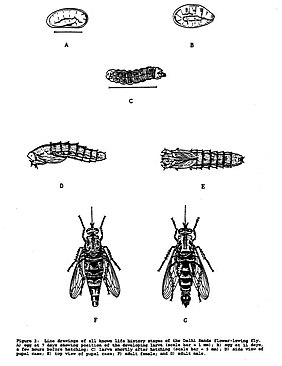Delhi Sands flower-loving fly
[1] The rest largely now form much or all of the foundation on which the towns of Colton, Fontana, Rancho Cucamonga, Rialto, and Ontario, California are built.
Adult R. t. abdominalis flies are only active for a few weeks each year, feeding on flowers in June, July, August and September.
The species was emergency-listed by the United States Fish and Wildlife Service on September 23, 1993, which has been an extremely contentious listing ever since.
For example, Congressman Joe Baca proposed removing the Delhi Sands flower-loving fly off the Endangered Species List to encourage development.
It has an elongate body, much like that of a robber fly (Asilidae), but unlike asilids, it has a long tubular proboscis (mouthparts) that may be used, as in butterflies, for extracting nectar from flowers.
The Delhi Sands flower-loving fly is approximately 2.5 centimeters (1 inch) long, orange-brown in color, and has dark brown oval spots on the upper surface of the abdomen.
Rhaphiomidas is a North American genus of 19 species and 5 subspecies, which inhabit arid regions of the southwestern United States and northwestern Mexico.
[15] Later in the same publication, the Delhi Sands flower-loving fly was described as Rhaphiomidas abdominalis, based on an adult male collected in August 1888 in Colton, California.
In 1941, when both R. terminatus and R. abdominalis were described, Cazier had only two specimens of each taxon available for examination, and these individuals appeared to represent distinct species.
However, when the genus was revised (Cazier 1985), it was determined that abdominalis is a subspecies of R. terminatus, based on abdominal spot patterns and other morphological characters.
[1] The Delhi Sands flower-loving fly undergoes a complete metamorphosis (egg, larva, pupa, and adult).
The life span of this animal is unknown, but the larval stage may last two years or longer, depending on availability of food, temperature, rainfall, and other environmental conditions.
Rogers and Mattoni (1993) described their observations of two male and two female captive Delhi Sands flower-loving flies.
A single acanthophorite consists of a circle of strong spines that can be rapidly revolved to serve as a drill adapted to boring through sandy soils, enabling the abdomen to be inserted almost completely underground.
[11] In all instances, the pupal cases were found on the surface of hardened sand in open areas at least 5 feet (1.5 m) from perennial plants.
The introduced Argentine ant (Linepithema humile) was observed to attack and kill a recently emerged adult Delhi Sands flower-loving fly.
The most characteristic feature of all known sites of Rhaphiomidas terminatus abdominalis is their fine sandy soils, often wholly or partly sand dunes stabilized by the sparse native vegetation.
Santa Ana winds continue to carry sand down from the mountains, but the dune system has largely been eliminated by urban development and agricultural conversion.
Delhi series soils cover about 40 square miles in several irregular patches extending from the city of Colton to Ontario and Chino in northwestern Riverside and southwestern San Bernardino Counties.
[19][20] The Delhi series soils are a biologically sensitive and very rare environment, and are inhabited by a number of plant and animal species of special concern.
Since the animal was listed, construction of a hospital, commercial development, and dumping of cow manure and other trash have eliminated populations and restorable habitat.
Non-native plants of concern include Russian thistle (Salsola tragus), horehound (Marrubium vulgare), mustard (Brassica tournefordi), cheeseweed (Malva parviflora), and many species of introduced grasses such as ripgut (Bromus diandrus) and red brome (Bromus madritensis ssp.
[1] These plants likely alter the amount of soil moisture or make the substrate physically unsuitable for the survival of the Delhi Sands flower-loving fly and other native subterranean invertebrates.
[28][29][30] Tons of cow manure from local dairies have been dumped on several sites containing restorable habitat for the Delhi Sands flower-loving fly, often apparently without permission of the landowners.
Note that the recovery units do not include residential and commercial development, nor areas that have otherwise been permanently altered by human actions.

